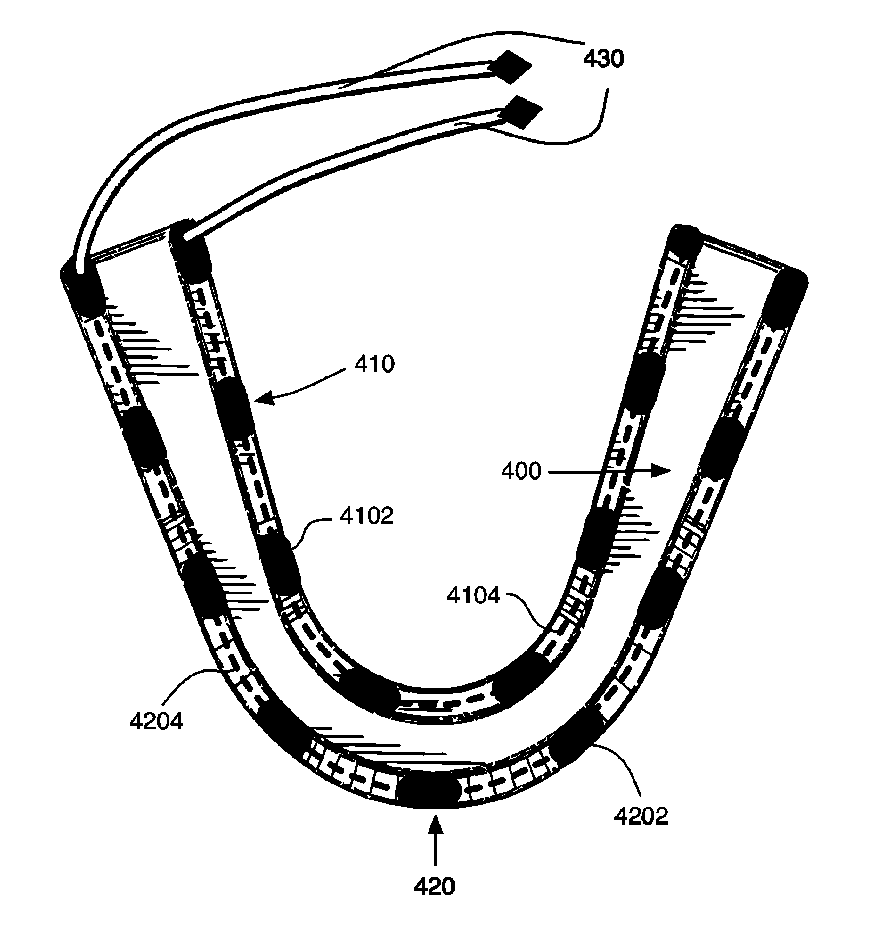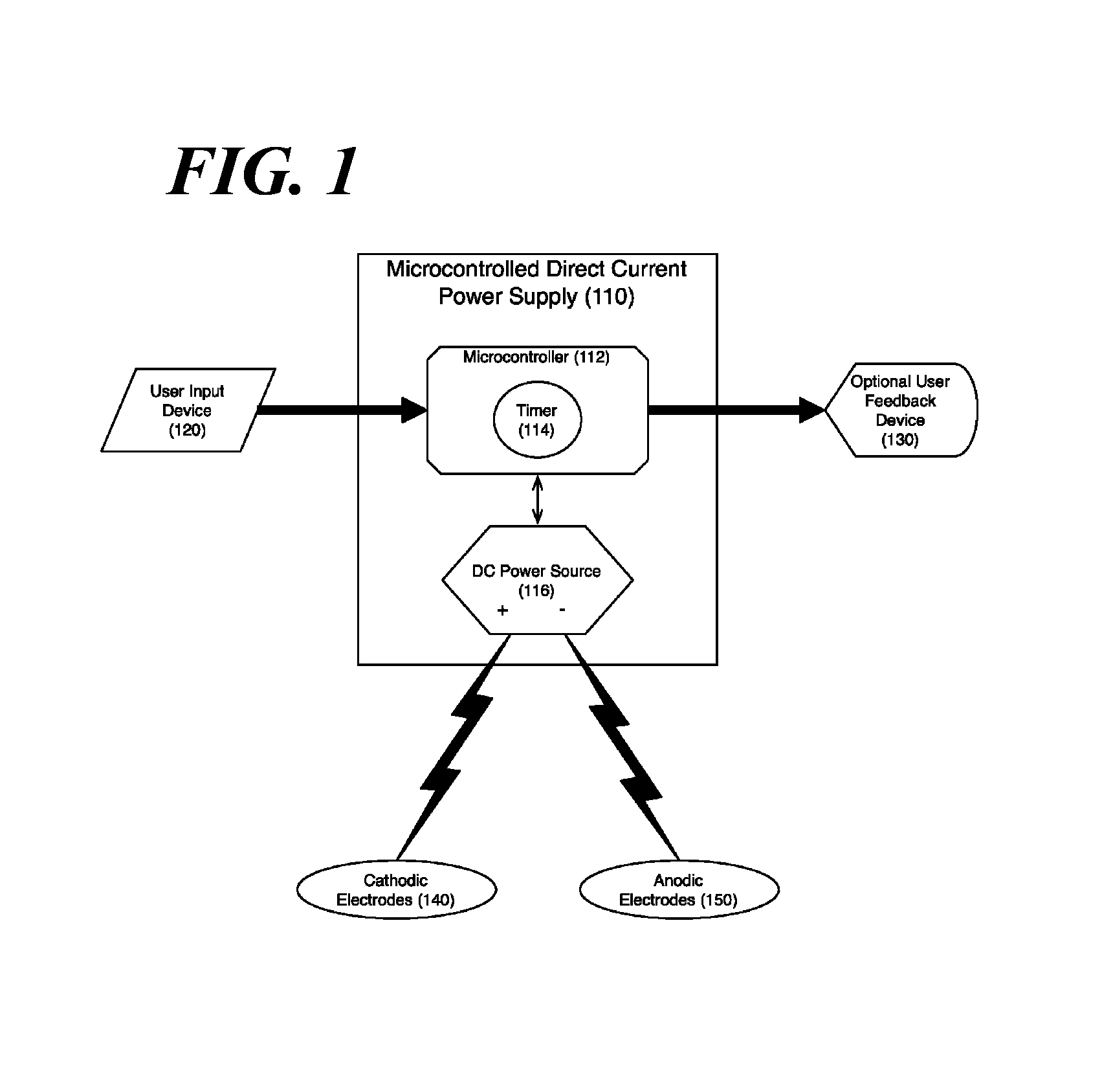However, prolonged gingivitis leads to the formation of periodontal pockets, gingival recession, and
bone resorption.
If left untreated, gingivitis may develop into perdiodontitis, a condition that may ultimately result in
tooth loss.
Methods and devices such as those presented by Nachman in U.S. Pat. No. 4,244,373 of Jan. 13, 1981 and by Detsch in U.S. Pat. No. 4,509,519 of Apr. 9, 1985 and by Liebergesell et al. in U.S.
patent application Ser. No. 11 / 499,033 of Nov. 30, 2006 may treat gingivitis but do not offer any way to reverse gingival recession and regenerate any lost
gingival tissue.
Gum recession causes many oral care and oral
hygiene problems.
The exposed root greatly increases sensitivity to heat, cold, and sweets, which can cause discomfort and even pain.
The exposed root is also much more vulnerable to tooth decay, greatly increasing the chances for
tooth loss.
These surgeries, however, are invasive, costly to the patient, require
anesthesia, and usually require two to four weeks of
recovery time.
This type of
surgery also causes scarring to the gingival area receiving the graft.
There is an additional risk that the gum graft
surgery may actually increase the rate of gum recession.
These methods and devices may be effective in promoting gum growth, but are not effective in killing oral microbes, treating gingivitis, increasing oral circulation or promoting osteogenesis (e.g. Yates, U.S. Pat. No. 5,741,500, Apr. 21, 1998).
While the effect of regenerating gingival tissues is desirable to the user, such methods and devices fall well short of an all-in-one oral
hygiene device.
There are electrical stimulation methods for inducing regeneration, similar to Zanakis et al., U.S. Pat. No. 5,433,735 of Jul. 15, 1985, which have shown promise for generic tissue regeneration, but have not been specifically implemented for gingival tissues.
Once again, however, this method of regeneration also does not address any other oral malady such as gingivitis, perdiodontitis, fungal infections, or poor oral
blood flow.
Likewise, these
alternating current methods are not able to provide the benefits of increased oral
blood flow, increased osteogenesis, and gingival regeneration.
Electrical current dental treatment devices (see Nachman, U.S. Pat. No. 4,244,373, Jan. 13, 1981) are known to be effective in promoting osteogenesis and treating perdiodontitis, but do not address gingival regeneration.
And while this device may be able to kill the
bacteria associated with gingivitis and perdiodontitis, the current levels are too low for this device to be effective in killing other types of oral microbes, including fungi.
Additionally, in some embodiments, this device creates a current flow not limited to the gingival region, but instead traveling throughout the body, which may have unknown adverse effects.
These embodiments also require the use of a
wrist strap
electrode and
electrolyte solution, which, at the very least, is inconvenient and cumbersome for the user.
However, this method does not address gum regeneration in any way.
As with some other treatments, the configuration of this device is inconvenient and possibly uncomfortable for the patient.
Likewise, if a patient were missing a tooth or perhaps many teeth, such an apparatus would not be able to be used to treat those regions of the mouth lacking teeth.
This is cumbersome, unwieldy, and unsightly for the patient.
Another problem with the existing direct current
oral treatment methods and devices of Nachman, U.S. Pat. No. 4,244,373 of Jan. 13, 1981 and of Detsch, U.S. Pat. No. 4,509,519 of Apr. 9, 1985 is that such methods are not effective at killing oral
fungus.
In certain cases, as with an immune-deficient patient, the
immune system is not able to control these normally harmless fungal infections.
Thrush by itself is harmless, but provides a danger since the Candida yeasts can spread throughout the body causing widespread infection.
These types of systemic infections can be very serious to patients with weakened immune systems, like those undergoing
chemotherapy or those having other immunodeficient conditions such as HIV.
While this method may be effective in killing some types of oral
bacteria and thus treating oral malodor, the patient faces an added risk of potentially damaging each tooth's pulp.
Necrosis of the pulp can begin with as little as a 5.5° C. increase in pulpal temperatures, which is a risk with any method that heats the teeth.
And while it is possible that such a method can also help with tooth remineralization, this process requires an
external source of
fluoride, as it is not readily available in
saliva.
Even though such a method may be able to treat oral malodor and kill bacteria, still it is limited in that it does not utilize any type of electricity to stimulate the oral tissues.
This renders such a method ineffective at treating conditions of gingival recession or fungal infections.
This is inconvenient, painful, and costly to a patient.
Other non-invasive methods using direct current for osteogenesis exist but are designed solely for osteogenesis and are not designed to treat gingivitis, increase blood flow, or regenerate gums (e.g., Korostoff et al., U.S. Pat. No. 4,153,060, May 8, 1979).
 Login to View More
Login to View More  Login to View More
Login to View More 


